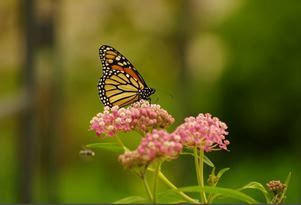
|
One of the state’s most distinctive signs of a new season is on its way – the brightly colored monarch butterfly. A well-known and beloved butterfly species in North America, monarchs, unfortunately, have become a much less common sight in recent decades.
The eastern monarch butterfly population has declined by more than 80 percent over the last 20 years, primarily from habitat loss, both in their summer range – including Michigan – and in Mexico, where they spend the winter.
“Adult monarch butterflies require a variety of flowering plants for nectar,” said Hannah Schauer, wildlife communications coordinator with the DNR. “Grasslands provide a mix of plant species that pollinators, like the monarch, need – with both early- and late-blooming plants and those that flower mid-summer.”
Monarchs returning to Michigan will depend on these early-blooming plants to refuel and build up their energy, so they can lay eggs for the next generation.
Grasslands also support milkweeds, vital to the monarch’s reproductive cycle because they’re the only species of plants that monarch caterpillars eat. Milkweeds also provide food resources for other animals.
A backyard garden can provide important habitat for pollinators, too, so consider these tips as you plan for this year’s garden. When you do start spotting monarchs, be sure to report those sightings because it helps inform conservation decisions here in Michigan. Report sightings and track their migration at Journey North.
Related, the Midwest Association of Fish and Wildlife Agencies recently shared a new draft plan aimed at reversing the decline of the eastern monarch butterfly populationand is welcoming public review and comment on it.
Find out more about ways you can help monarchs in Michigan by visiting michigan.gov/monarchs or contacting Hannah Schauer at 517-388-9678.